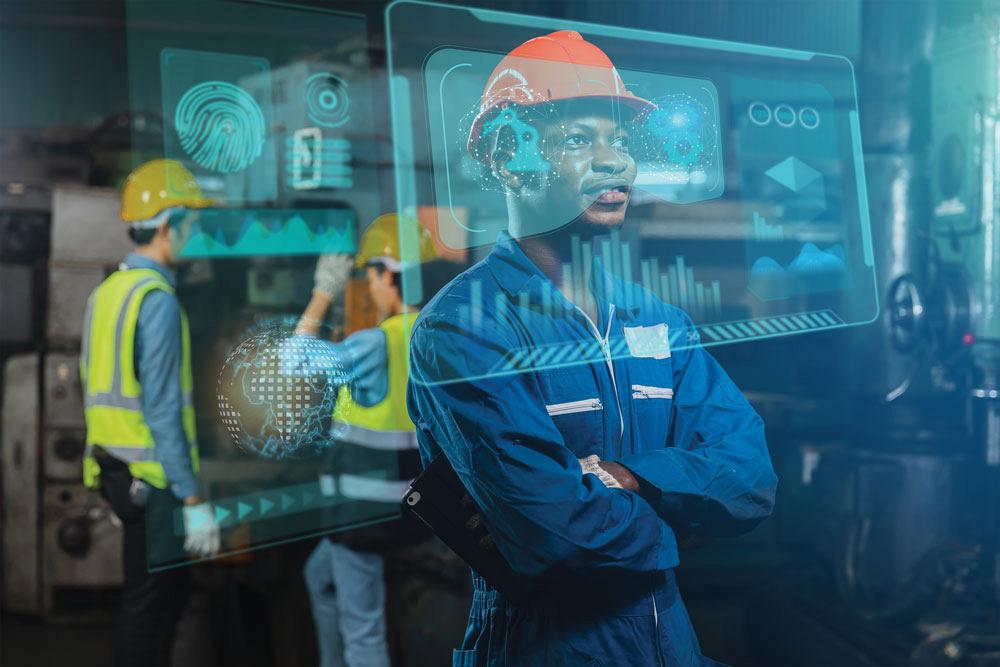Co-founder/COO
- FMA
- The Fabricator
- FABTECH
- Canadian Metalworking
Entering the manufacturing Metaverse
How 3D-based AR/VR is driving today’s manufacturing automation and robotics technologies
- By Dijam Panigrahi
- September 2, 2022
- Article
- Automation and Software
The evolving business climate of 2022 caused by the continuing pandemic fallout, as well as spinoff issues such as supply chain, labour, and inflationary challenges is forcing many manufacturing executives to implement automation and robotics technologies in their production, distribution, and fulfillment facilities.
Ongoing economic challenges, along with steady pressure from business investors focused on the bottom line, have added pressure to companies that need to become even more efficient with their factory operations and product development teams.
Sure, many manufacturing facilities continue to rely on human labour, but an increasing number of manufacturers now are implementing automation and robotics technologies powered by augmented reality and virtual reality (AR/VR) to speed efficiencies, lower costs, and minimize human touch points to ease the pain caused by staffing shortages.
According to the Wall Street Journal report “Robots pick up more work at busy factories,” demand for workplace robots in the U.S. rose by a record 40 per cent during the first quarter of 2022 compared with the same period in 2021. The report’s data came from the Association for Advancing Automation (A3), which tracks trends in the robotics industry.
Investing in Automation
Automation-driven robotics has been widely used in the automotive sector, such as assembly lines production, but now other industries like aerospace, retail and food production, construction equipment, and pharmaceuticals are seeing gains in the use of these machines on the plant floor.
The business benefits of increased productivity and reduced costs obviously are a boon to the bottom line. However, other leading drivers show that these technologies are helping to enhance new social distancing policies enacted during the early days of the pandemic.
Increased Flexibility Across Manufacturing Facilities
The COVID-19 pandemic illustrated the need for more operational flexibility in situations where advanced technology and automation can be applicable. In addition, the ability to scale up or down quickly to meet project deadlines without impacting hourly shifts has further helped with manufacturing efficiency.
Use of technologies such as AR/VR-driven robotics and automation also have greatly increased across plant floors, especially as the need to adhere to tighter supply chain and logistics demands now is paramount.
As we move through 2022, continued disruptions to the global supply chain are becoming the new normal, and manufacturers continue to address the cascading events in different ways. For example, improving supply chain visibility and increasing customer satisfaction clearly are important. Better automation-driven technologies are paving the way for improvements in these areas.
Cloud-based Automation Technologies Are Pivotal
AR/VR is necessary today in automation and robotics technologies, but there are important areas to understand when leveraging such technology for manufacturing applications.
The technology allows designers and manufacturers the ability to conduct real-time 3D visualization and CAD for design and manufacturing; faster training cycles; and professionals can work at drastically higher productivity levels. In fact, some manufacturers report minimized errors using AR/VR through instructions overlay, remote assistance, and better planning and visualization. This has resulted in a more than 40 per cent increase in productivity in some instances.
AR/VR technologies provide significant time savings to the manufacturing build process through optimized decision process, which positively impacts the entire OODA (Observe, Orient, Decide, Act) loop.
One caveat facility managers must take into account is that not all automation technologies are created equal. It is important to pay close attention to the technology infrastructure and to choose a platform that is cloud-enabled so that projects can truly scale when needed. Manufacturers are overcoming their growth limitations by leveraging cloud-based (or remote server-based) AR/VR platforms powered by distributed cloud architecture and 3D vision-based AI. These cloud platforms provide the desired performance and scalability to drive innovation in the industry at speed and scale.
The use of robotics and AR/VR-driven automation technologies requires the right speed and data for accuracy. Even though technologies like AR/VR have been in use for several years, many manufacturers have deployed virtual systems that are built upon an on-premise environment, where all the technology data is stored locally.
On-premise AR/VR infrastructures limit the speed and scalability needed for today’s virtual designs, and it limits the ability to conduct knowledge sharing between organizations that can be critical when designing new products and understanding the best way for virtual buildouts. This is especially critical as manufacturers enter a new phase of business operations centred around the Metaverse.
Modelling Powers the Metaverse
The manufacturing Metaverse is a network of virtual systems and digital twins connected to real-world machinery that enable manufacturers to connect their digital assets to those of their customers and suppliers. This creates a collaboration in the virtual world that is based on real-time data.
Automation and robotics will prove especially beneficial as more manufacturers adopt technologies for the Metaverse – a virtual world where products are designed, produced, and brought to market. In this virtual Metaverse, digital twins based on modelling and simulation play a leading role. Simulation allows companies to take copies of the digital twin, run simulations on it, and then identify optimizations that are too complex to find by monitoring the physical environment alone.
The power of simulation will be a game-changer for businesses throughout the Metaverse in numerous industries, such as optimizing production planning in the automotive sector, accelerating design in the aerospace industry, improving overall production efficiency for manufacturers, and increasing accuracy for consumer-packaged goods companies. Many companies are poised to leverage virtual simulation to make better business decisions and generate the greatest ROI.
The best immersive reality systems are needed to support ultra-realistic, high-fidelity digital twin visuals during the modelling and simulation process; precise fusion of the virtual and real world in a multiplatform environment; and the ability to demonstrate a variety of realistic environments.
The Metaverse is a new kind of application, which is enabled by tight integration between real and virtual worlds. It is enabled by a multitude of new technologies broadly in these five groups:
- Communications and Computing Infrastructure. The Metaverse needs to perform large-scale, computer-heavy tasks and access large databases to merge the real and virtual world.
- Management Technology. The Metaverse needs a lot of resources like energy and computing power.
- Fundamental Common Technology. AI and spatio-temporal consistency are fundamental common technologies for the Metaverse.
- Virtual Reality Object Connection. The Metaverse creates a 1 to1 connection between real- and virtual-world objects and technologies like blockchain, and identity modelling enables it.
- Virtual Reality Space Convergence. Metaverse fundamentally needs a new medium to interact. AR/VR/MR, BCI, and gaming technologies will enable this.
Immersive reality system providers offer many foundational technologies to run an industrial enterprise Metaverse, including:
1. Virtual Reality Space Convergence
a) AR/VR
• Ultra-low latency, high-fidelity rendering. Low latency is extremely critical to provide an immersive experience in the Metaverse. AR/VR partners provide unparalleled realism of environments by leveraging ultra-low latency remote rendering on-cloud/on-premise in full fidelity, and wirelessly streaming the end result to affordable commercial off-the-shelf devices, like tablets and desktop computers.
• High-precision, 3D, AI-based spatial mapping. High-fidelity remote spatial mapping with high-fidelity 3D scene reconstruction, scene segmentation, and 3D object recognition using 3D vision and deep learning-based AI with precise fusion of the real and virtual worlds merges the real world and virtual worlds.
b) Game engine
• Consumer game engines have limitations that they only can handle a Metaverse that can fit in a single server. The Metaverse will be ever-growing as more digital twins are created to simulate real objects in the virtual world. Some AR/VR providers have created a data-centric simulation engine which scales for any complexity of Metaverse.
2. Communications and computing infrastructure
a) Cloud computing/edge computing
• Industrial enterprises always should subscribe to multicloud, edge-cloud computing. Depending on different factors like data sensitivity, latency, and cost, different parts of the Metaverse need to be run at different clouds/edge computers in a distributed manner. Any AR/VR partner you choose should automate running the Metaverse for your industrial enterprise.
b) Messaging framework
• In the distributed Metaverse, there is a need to update the Metaverse at global scale so users can collaborate seamlessly. Your AR/VR partner should have messaging framework updates distributed to the Metaverse at global scale.
In addition to these requirements, security and privacy is one of the biggest issues facing today’s world. Since the Metaverse has the digital twin as an integral part, the Metaverse will have much richer data. The security and privacy in the Metaverse cannot be solved by traditional security tools. Your AR/VR partner needs to have tools that handle security and privacy related to digital twins.
The Metaverse is going to be important for all manufacturers and businesses as they include more automation and robotics into their processes leveraging AR/VR systems. It’s the next step.
Dijam Panigrahi is the co-founder/COO of GridRaster Inc., 1931 Old Middlefield Way, Suite G, Mountain View, Calif. 94043, info@gridraster.com, www.gridraster.com.
About the Author

subscribe now


Keep up to date with the latest news, events, and technology for all things metal from our pair of monthly magazines written specifically for Canadian manufacturers!
Start Your Free Subscription- Industry Events
Automate 2024
- May 6 - 9, 2024
- Chicago, IL
ANCA Open House
- May 7 - 8, 2024
- Wixom, MI
17th annual Joint Open House
- May 8 - 9, 2024
- Oakville and Mississauga, ON Canada
MME Saskatoon
- May 28, 2024
- Saskatoon, SK Canada
CME's Health & Safety Symposium for Manufacturers
- May 29, 2024
- Mississauga, ON Canada






















